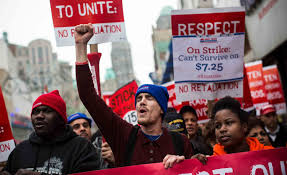Wage Wars

Low income workers take to the streets to protest their low wages (pbs.org).
In 2013, 200 fast food employees from fast food restaurants including McDonald’s and Taco Bell staged a walkout in New York City to protest the low wages they had been receiving. This one small act sparked a nationwide movement to raise minimum wage. Three years later, those 200 individuals became 200 cities. As of April 13th of this year, 60,000 low-wage-earning workers ranging from drugstore cashiers to daycare employees have become members of the Fight for $15 campaign — a campaign, historians say, that has become the largest America has ever seen.
In recent months, fast food employees have pushed for major salary increases. They are hoping to increase minimum wage to $15 per hour across the nation. “They used to think $15 was impossible. Now it’s popping up everywhere,” said Kendall Fells, the national active advocate of the Fight for $15 campaign.
The increase in income, the campaign argues, would dramatically help low wage workers’ standard of living. And it would, at least temporarily, according to opposers of the campaign. People outside the movement are afraid of what lasting effect the movement will have on the economy. They believe that, in the long run, the movement will disrupt the economy and cause serious inflation.
Nevertheless, the campaign found success in Los Angeles on May 15th, passing the bill in the City Council with a 14-to-1 vote. The ruling promised to increase LA’s minimum wage from $9 to $15 by 2020. The campaign members have now shifted their focus elsewhere, look now to rising wages in New York. They are currently asking for donations to fuel their cause on their site.
You can find more details about the Fight for $15 campaign at http://fightfor15.org/





